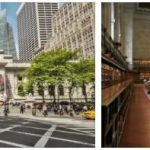Statue of Liberty (New York)
Statue of Libertyis considered the most valuable gift from France to the United States. During the American Revolution, France gave the United States the Statue of Liberty, a symbol of freedom for the oppressed. It is located in New York City.
Highlights of the Statue of Liberty
- Located on Liberty Island, in New York Harbor, the Statue of Liberty has been offered as proof of international friendship by the people of France to the people of the United States and is one of the most universal symbols of political freedom. and of democracy; its official name is Liberty Enlightening the World Liberty Enlightening the World.
- Inaugurated on October 28, 1886, the Statue of Liberty was classified as a National Monument on October 15, 1924 and restored to commemorate its first centenary, on July 4, 1986.
- The 25 windows of the crown symbolize precious stones found in the land of rays of the sun illuminating the world; the seven rays of the crown represent the seven seas and continents of the world; In the table that the figure holds in his left hand, it can be read July 4, 1776-.
- According to campingship, the visit to the crown of the Statue of Liberty can mean a two or three hour wait in line and requires the climb of 354 steps 22 floors, not advisable for people with health problems.
- The observation deck on the pedestal offers a spectacular view of New York Harbor and can be reached by a 192-step staircase or by elevator.
- For visitors short on time, the museum on the statue’s pedestal explains how the monument has been conceived, built and restored.
- The only transportation to Liberty Island is the Circle Line ferries – Statue of Liberty Ferry, Inc “.
Replicas and imitations
- In the Spanish town of Cenicero there is a Statue of Liberty dating from 1897.
- A prototype of the statue is located in Paris, France, near the Grenelle Bridge on the Isle of Cygnes, on the River Seine. It measures 11.5 m tall. He looks to the west, facing his older sister.
- From 1887 to 1945, Hanoi was home to another copy of the statue. It was 2.85 m high and was erected by the French colonial government, after being sent to France to be exhibited. It was known by the locals as the -Statue of the lady with the open dress-. When France lost control of French Indochina during World War II,the statue was toppled on August 1, 1945, after seeing it as a holdover from colonial rule.
- Deluth, Minnesota, has a small copy in a convention center, but being surrounded by pine trees it goes unnoticed.
- Between 1949 and 1951, approximately 200 2.5m replicas, made of copper, were purchased by the Boy Scouts and donated to various cities in the United States. The mass produced statues are not great or an exact copy, a note to that says that – her face is not mature like the real one, it is rounded and more like a girl. But these statues are loved, especially after the September 11 attacks. Many of them have been destroyed, but preservationists have counted close to 100 and a group of Boy Scouts from Cheyenne, Wyoming has collected photographs of more than 50.
- Another copy is the Statue of Liberty in Bordeaux. It measures 2.5 m and is in the city of Bordeaux in southwestern France. The first statue was toppled and destroyed by the German army in WWII. The statue was replaced in 2000 and later a plaque was added commemorating the victims of September 11.
- A bronze sculpture of the Statue of Liberty is on display at the Metropolitan Museum of Art in New York.
- There is a half-size copy at the -New York-New York Hotel and Casino- in Las Vegas, Nevada.
- In Buenos Aires, Argentina, in the Barrancas de Belgrano park , there is a small replica acquired by the Municipality from France. In 1986 it had to be restored due to deliberate damage.
- In Gibara, Cuba ], in the Calixto García park, old Plaza de Armas. It was obtained through popular fundraising and commissioned from Italian sculptors.
World Heritage
| Statue of Liberty | |
| Name described on the World Heritage List. | |
| Coordinates | N40 41 22 W74 2 41 |
| Country | Spain |
| Guy | Cultural |
| Criteria | (i) (vi) |
| Identification no. | 307 |
| Year of enrollment | 1984 (VIII session) |
| Place of celebration | New York |
The statue was included on the List of World Heritage of UNESCO in the year 1984.
Justification of the registration
- Criterion (i): This colossal statue is a masterpiece of the human spirit. The collaboration between the sculptor Frédéric Bartholdi and the engineer Gustave Eiffel, resulted in the production of a technological marvel that brings together art and engineering in a powerful new way.
- Criterion (vi): The symbolic value of the Statue of Liberty lies in two basic factors. It was presented by France with the intention of affirming the historic alliance between the two nations. It was financed by international subscription in recognition of the establishment of the principles of freedom and democracy of the Declaration of Independence of the United States of America, which the statue holds in its left hand. The statue was also soon made and has endured as a symbol of the migration of people from many countries to the United States in the late 19th and early 20th centuries.. She remains a very powerful symbol: inspiring contemplation, debate and protest of ideals such as freedom, peace, human rights, the abolition of slavery, democracy, and opportunity.
Integrity
Within the property limits are all the elements necessary to understand and express the exceptional universal value of the Statue of Liberty. The statue has stood through its life without any major changes. The deformations related to the galvanic interaction of the metals were corrected in a deep restoration undertaken for its centenary in 1986, which included the reproduction of the original deteriorated torch, which is now kept in the museum. There have been regular updates to the mechanical and internal security systems. The 5.95 ha property is of sufficient size to adequately ensure full representation of the features and processes that convey the meaning of the property, and does not suffer from the adverse effects of development and / or neglect. There is no official protection zone for the property, but its location on the island within the urban setting offers equivalent protection. The property, which is the entirety of Liberty Island, also has a number of administrative structures.
Authenticity
The Statue of Liberty is authentic in its location and surroundings, form and design, materials and substances, use and function, and spirit and feeling. The design and purpose of the statue have been preserved from the time of its construction. The internal iron frame was replaced in 1986 with stainless steel that prevents corrosion. All repairs were made with great fidelity to the original design and materials. The circulation, and periodic mechanical security updates have not affected the sculptural and symbolic values of the monument, and have been done to ensure the safety of the visitors. There is a formal property monitoring program. Known and potential threats to the authenticity of the property include pollution, bad weather, and large numbers of visitors.
Protection and management requirements
The Statue of Liberty is the property of the Government of the United States of America. The statue was designated as a National Monument in 1924 (the National Monument also includes Liberty Island 1937 and Ellis Island 1965), and is managed by the National Park Service. These measures provide the highest level of protection possible. The current General Management Plan (1982), which addresses physical preservation and interpretation, has been supplemented in recent years by an exhaustive study on life-safety and emergency management (2009), of which the recommendations have been applied. The statue receives a large number of visitors, and has substantial professional staff and facilities that include a Visitor Information Center, an exhibit on the statue’s history, and the nearby Ellis Island Immigration Museum. Access is by ferry, which includes security control for visitors; Maintaining the security of the property is a constant concern.
Maintaining the property’s Outstanding Universal Value over time will require continued monitoring and management of known and potential threats, including contamination, severe weather, and large numbers of visitors.
Central Park (New York)
Central park. One of the most famous urban parks and that we all know at least from seeing it in movies and television series. New York’s Central Park was the first public park in the United States and without a doubt, it is the most visited in the country. In addition to its public areas, Central Park is the scene of the Zoological Garden, restaurants, a famous skating rink in winter and above all, a panoramic viewpoint of the Manhattan skyline.
History
The 21 of July of 1853, the Legislature of the State of New York passed a law designating land in the middle of Manhattan for a large public park; the nation’s first large public park. The Park was designed in 1858 by Frederick Law Olmsted and Calvert Vaux; who envisioned it as a place where people of all races and social classes could mix. From treeless, rocky and swampy terrain they created a wooded urban oasis that has been enjoyed by generations for the past 150 years.
The northern and southern parts of the park were the first to be completed and were opened to the public in 1861 while the rest of the park and its hills, roads, and ponds were under construction for 16 years.
Ten million carts of dirt were used to cover the swamps and rocks, while an underground drainage system was installed to create ponds and lakes. In recent years, Central Park has undergone a renaissance as in the 1970s its trees and gardens were neglected, its picturesque bridges and buildings covered in graffiti, its statues defaced and its benches broken.
In 1980 the Central Park Conservation Commission was founded with the mission of restoring, managing, and conserving the Park, managing to organize, develop and implement a restoration plan that has set new standards in park care. Today, Central Park has more than 26,000 trees, 58 miles of scenic driveways, and nearly 9,000 benches on 843 acres. Each year, 25 million people from New York, the rest of the country, and around the world visit the Park.
Location
The park is run by the Central Park Conservancy, a private non-profit company, which has a contract with the New York Department of Parks and Recreation. Central Park borders 110th Street to the north, West Central Park Street to the west, 59th Street to the south and Fifth Avenue to the east. The sections of these streets that pass around Central Park are generally known as Central Park North, Central Park South and Central Park West, respectively; although Fifth Avenue retains its name as it passes the eastern edge of the park.
Decline
The park also suffered times of decline. In the 1930s, Mayor Fiorello La Guardia brought him out of laziness. Then he brought in legendary urban planner Robert Moses, who expanded the recreation areas, which would have horrified the original architects. Games for children and areas for different types of sports and concerts were erected, and the zoo was expanded.
In the 1960s the park became the heart of New York’s protest and political activity, and little by little it began to fall into disrepair again. Terrible crimes also took place there. In the mid-1990s, two teenagers – a girl and a boy – cut the throat of a 40-year-old man and threw him into the lake. The case of the Central Park Jogger, a woman who was raped by a boy band, continues to generate headlines in newspapers across the United States. Despite this, Central Park remains the pearl of New York.
The lawns, the flowers, the trees receive meticulous care from the commune and a private society that raises funds for their conservation. More than 20 million people visit it a year, because its landscapes are magical with sun, rain or snow.









